
I wanted a place to put my local moth photos so I could show, organize, and maybe even identify some of them. Names are given when I know what they are. Unknown types will have a photo date-based (mmddyy) reference number. Most will be the more common or eye-catching types more likely to be seen. This is not meant to be comprehensive, but more a grab-bag assortment of the 'most likely to bumble into without trying' types. They are broken into various related groups (often by family) below. Once it gets filled in a bit you might be able to at least place one you saw in the right group. The first step towards an identification.
Butterflies and moths are in the order Lepidoptera. Scale-winged insects. Their wings are covered in scales. Generally butterflies are diurnal, moths are nocturnal. However there are exceptions, one can get the occasional butterfly to come into a light at night. There are also a fair number of dayflying moths, several groups are mostly such. Butterflies have knobbed antennae, a little ball at the tip of each. Moths are often straight with no knob, or, feathered. Moths mostly hold wings open spread flat when perched, or along sides of body. Most butterflies hold them together over their back when perched. There are a number though that keep wings spread flat like moths, like Duskywings, which are brown like many moths as well. So it is hard to find hard fast rules without exceptions in separating them. The knob tipped antennae of the butterflies might be the most solid always works infallible most obvious distinction. Generally one might say butterflies are more colorful, and sure there are more brown and camo moths. But many moths are spectacular of colors and patterns, and many butterflies are camoflaged in browns.
The butterfly people often hang around flowers and might even drink a beer in the heat of the day waiting for something to fly in. The moth people stay up late watching lights, often involving UV, and various distilled spirits. Beware the butterfly AND moth people. :)
There are I think over a thousand species (1100?) of moths known from the Edwards Plateau of central Texas. Surely several hundred species are found locally. Most are what are called micros, as in micro-moths, the little tiny small ones, which I generally ignore. Way above my pay scale and micro-brain capabilities. I like the low-hanging fruit of big, pretty, and fancy when something I know so little about.
This is just a start to get the page going. This first set of pix have mostly been used here before, but are scattered all over many pages. This begins the organization. Will be adding family names, binomials when known, and other info as we go.
I count about 40 species shown so far. Which is maybe just a wee bit over 5 percent of the species diversity here. This is the tip of the iceberg of moth diversity here. With a lean toward big, fancy, and easy to identify.
If you see an incorrect ID I would really appreciate knowing, please don't hesitate to educate. We will try hard to not let that happen. I would also appreciate any ID's from the moth people. I have not gotten to the part of trying to identify most of them yet, save casual perusing of plates in Holland's 'Moths' book. Just like when I was 12.
~ ~ ~
SILK MOTHS - family Saturniidae
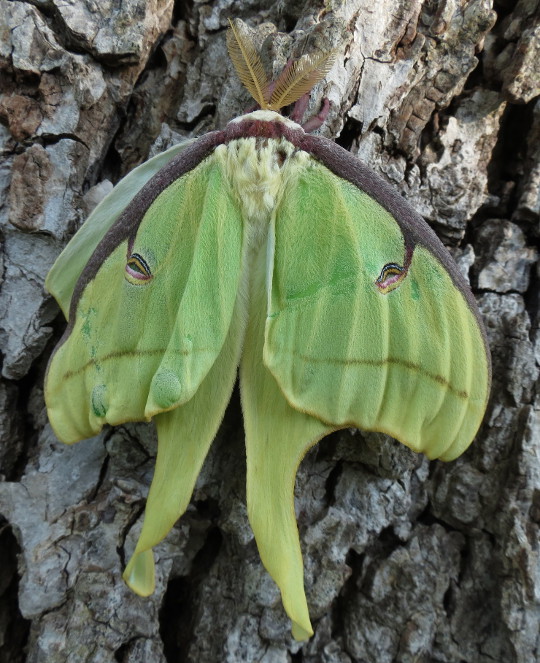
This is a Luna Moth pumping up and drying out just after
emerging from pupae on Sept. 2, 2019. They are 4.5" across!
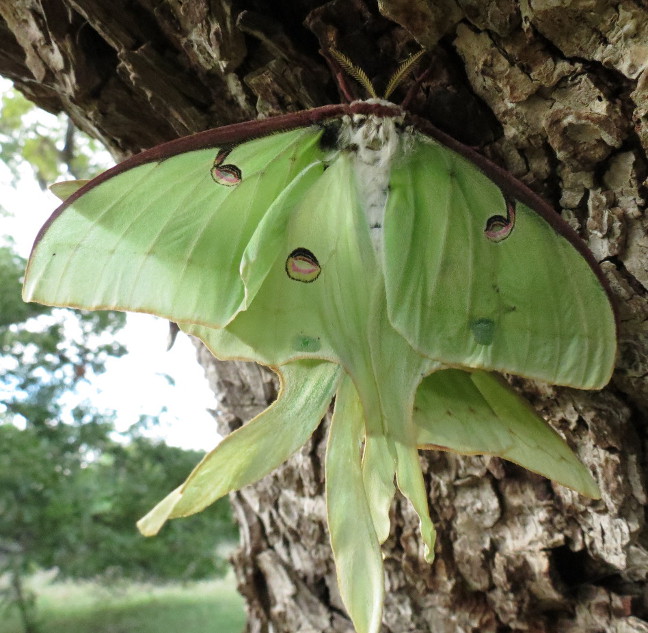
This is a mating pair of Luna Moth on Sept. 4, 2019.
They were on a big Pecan all day. Two days after above photo.

This is a Cecropia, one of America's fanciest silk moths.
Wingspan is about 5" and what a beauty! March 17, 2020.

Here is a pic of the Io Moth (Automeris io) that I picked up
at the gas station today, free with a fillup. August 13, 2021.
This is a male, females are browner of forewing, and of course you
do not see the amazing hindwing when wings closed as when on a wall.
These are amongst the smaller silk moths, just a couple inches across.

Junior sent me this great photo of an Io moth, on a wall Aug. 11, 2024. I have only seen one here, and it was dead at the gas station. It is also one of our silk moths, but of the smaller group around a couple inches long. If you are local to Utopia, I don't mind seeing pics of anything neat you saw, if you think of interest.

This is an out-of-focus Imperial Moth, nearing 4" across.
They vary in pattern but are a brick-reddish pink on yellow (Eacles imperialis).

This is a Polyphemus Moth. One of 17 that were at the Utopia General Store Aug. 7, 2024. Thanks for the call Shirley! On the right wing the thin dark marks are shadows from grass blades, not a field mark on the animal. This is one of a large gathering at General Store Aug. 7.

This is another of the Polyphemus Moth. Note how much variation there is in the species. Compare to last weeks photo. Some species often all appear to be clones, others have high variability, such as these moths.

This is a closeup of one of the Pllyphemus moths at the store last August. Anntennae like this are well-named as feathered. It is the males that have the big oversized ones, to detect females.
UNDERWING MOTHS (True Underwings - genus Catocala)

An Underwing (Catocala sps.) moth, July 22, 2016

One of the Catocala Underwing moths we have locally,
probably C. obscura, or something similar. They
are nearly invisible on tree bark. This is our most
numerous Underwing, with dull boring brown hindwings
you can just see the corners of. 060617. June 6, 2017
Some Underwings here have striking red, pink, or orange
with black bands on hindwings. Which you see when they
explode off a tree trunk. Some have names like Darling,
Sweetheart, and Girlfriend.
SPHINX MOTHS (aka Hawkmoths) - family Sphingidae
The Tomato Hornworm is a sphinx moth catepillar.
Some of them can be seen diurnally (in day).

Walnut Sphinx Moth is fairly regular locally. June 6, 2015
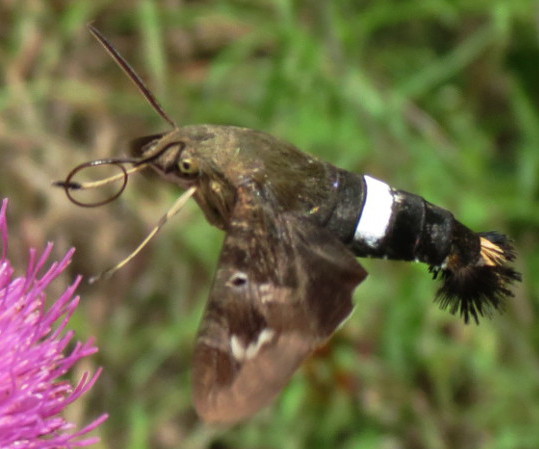
This is one of the Hummingbird Hawkmoths of the genus
Aellopos, and probably the species A. clavipes, July 11, 2021.
There are a few similar, but clavipes is the usual one.
They use front legs (pale) to steady themselves while nectaring.

You can see why people insist the tail was feathers while
holding their fingers an inch apart asking what bird it was.
They are almost 2" long and wingspan is almost 3".
Same individual as above.

This is an Obscure Sphinx (Erinnyis obscura) moth.
The orange-red is the hindwing, only a bit of the base shows.
In normal perched posture the wings are closed over them.
Imagine trying to spot that on a tree trunk. October , 2020

Vine Sphinx on Sept. 28, 2019

Lassaux's Sphinx, Aug. 30, 2018, at front porch. It had pink-orange hindwings and a black and white banded abdomen. It came into my pipe tobacco.

Have not ID'd this one up yet, but maybe Big Poplar Sphinx.
DIURNAL MOTHS (dayflying) - some moths nectar at flowers in daytime
Have to find my good Ctenucha pics, somewhere... These are not whatsoever related, all are in different families. Interestingly most day-flying moths are brightly colored or patterened like butterflies.

There was a bit of an invasion of White-tipped Black
moths this past fall. They are LTA - less than annual, here.
Neat how I cut off one of the white tips on the White-tip.
Call for free tips on how to screw up photos. Nov. 13, 2016.
(Melanchrioa chephise)

This is a Texas Wasp Moth (Horana panthalon texana),
a moth that mimics a wasp. Most folks, and more importantly
predators, would be hesitant to grab this harmless moth.
Oct. 6, 2020.
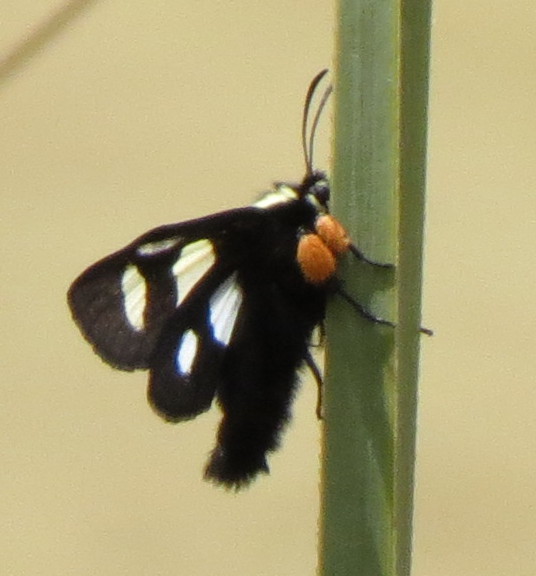
This is a Disparete Forester, Lost Maples, March 17, 2019. They are pretty fuzzy, especially the puffy orange leg bases. (Androloma disparata)
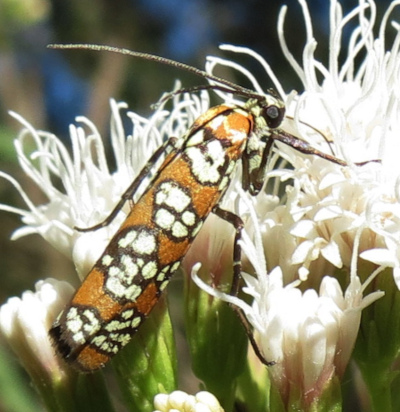
These are often on flowers in day, the Ailanthus Webworm moth.
Sorry about the digital sensor overexposure. (Atteva punctella)

One of the Lichen Moths, c.f. Lycomorpha pholus, often on flowers.
Sorry about the digital sensor over-exposure on the white.
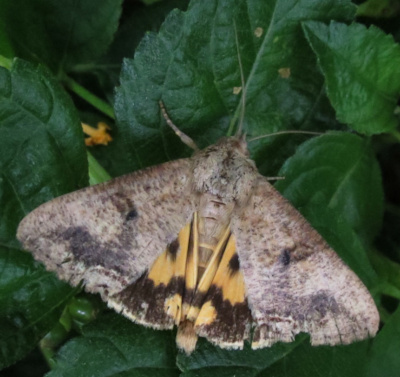
I think Hypocala andromena - Andromena Moth aka False Underwing.
Often seen on flowers in the daytime.
Miscellaneous Assorted Moths

Mating moths, June 12, 2022

There are a number of types that qualify for the name Bird Dropping Moth, this is one of them. There are nearly as many variations as there are in bird droppings, which surely you have studied.

Another exciting bird dropping moth, of which there are countless variations.

There were a bunch of these moths on the ground at the P.O. today.
Maybe one of the owlet moths. 032919. March 29, 2019
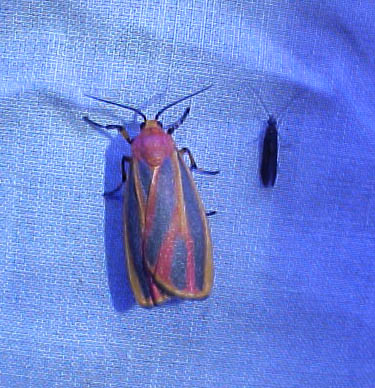
Lichen Moth (left) and a "micro" moth (R) of which there are hundreds of types here. I don't do micros, you have to draw the line somewhere. :) May 5, 2016
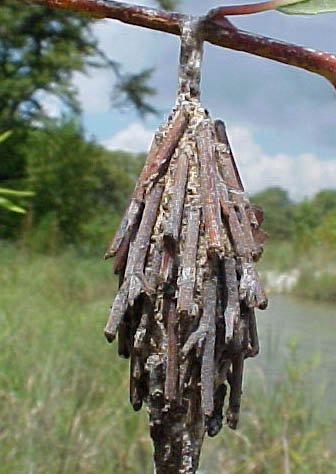
Bagworm. This is from a moth, the female is flightless and
lives in this bag. You might see these in trees along river.
Sept. 4, 2016

An unknown (as of yet to me) moth species, perhaps one of the owlet moths.
moth sps. 072615. July 26, 2015

moth sps. 062919a, June 29, 2019. Maybe a little over a half-inch long.

moth sps. 052716b, May 27, 2016.

Methinks a ghost moth sps, was at least two inches long.

moth sps. 061218a, June 12, 2018. Note the berry through clear wing.
Tiger Moths

This is the Tiger Moth we took back outside. Sorry about the docushot through glass. Wooly Bear caterpillars turn into this beauty, or another very similar species. Oct. 25, 2023. Family Arctiidae, genus either Grammia or Apentesis. Will try to get an ID. They are a couple inches across.

This is an Accrea moth, also in the Tiger Moth family. Tiger Moth caterpillars are wooly bears, the real fuzzy types. The black and red ones are from the first Tiger moth above this one, this one they are the yellow and white wooly bears you see. The Accrea moth is aka Saltmarsh Moth, of which there is none of around these parts.
Oh boy, brown moths. These are not related other than by color. A brown moth probably narrows it down to just 75 percent of known species. :) But if you take a close look at them and see all the beautiful shades and variations in patterners they can become interesting too. You have been warned... I have not identified these yet, they are a random sampling of probably common types.

This one is what is called mottled. How could you see that on tree bark?

This one is fairly pale and has some spots that sorta look like eyes.

Endless patterns and variations on how to camoflage oneself. We do not get to see the ones that did not work out. These are the successful examples.

Moths are to browns what plants are to greens.

I think this is a moth, an odd one at that. It was near a couple inches long. Oct. 4, 2024

You do not have to know the names of things to enjoy or appreciate them. Get pixels, and maybe one day you can ID it in the future.
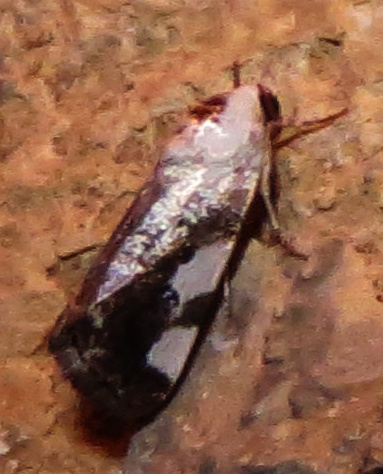
Another exciting moth.
~ ~ ~ ~ ~ ~
Now we have a skeleton framework where I can process moth images and file, sort, and toss them here to organize.
... like this one the other day...
Hot pink moth on cool purple flower

A rather pretty bright hot pink moth, on Mealy Sage.
Here is a pink one with orange squiggles.

The pink and orange is nice too. It was very small, about a half-inch. The flash nuked the wall though, so no anntanae visible.
Remember, each and every species plays a role in the web of life here. They too are part of the fabric of our ecosystem and environment. Just becaause we do not know or understand it, that does not mean it is not important. It just means we are not as all-knowing as oft pretended.
We hope you enjoyed this wee peek at the tip of the iceberg of moth diversity here. If you see something unusual at your porch light, take a photo so there is some documentation for experts to argue over. In the world of insect records, unfortunately photos or it didn't happen is the rule. Except for when that is not enough and they need a specimen to dissect. Which is the case for some butterflies too, and which is not all that uncommon either. So I will stick to the big, pretty, fancy, EASY ones.
Probably two of the best sources for getting identifications on insects are a couple websites: theBugGuide is great for working on any insect ID. You can post pix and eventually some experts will see it and know what it is. Another popular place used for that is iNaturalist. Again, you can post pics, and experts will ID just about any bug you can throw at them.
Bird News
Utopia Birds
Birding Sites
Bird List
Bird Photos
Bird Guide
Reports from Lost Maples
Winter Bird Count
Butterflies
Butterfly News
Butterfly List
Rare Butterflies
Butterfly Photos
Dragonflies
Critters, Bugs, & Stuff
Lost Maples
Garner State Park
Local Site Guide
Home

Our E-mail
mitch @ utopianature.com
 All photographs within this site are copyrighted
All photographs within this site are copyrighted